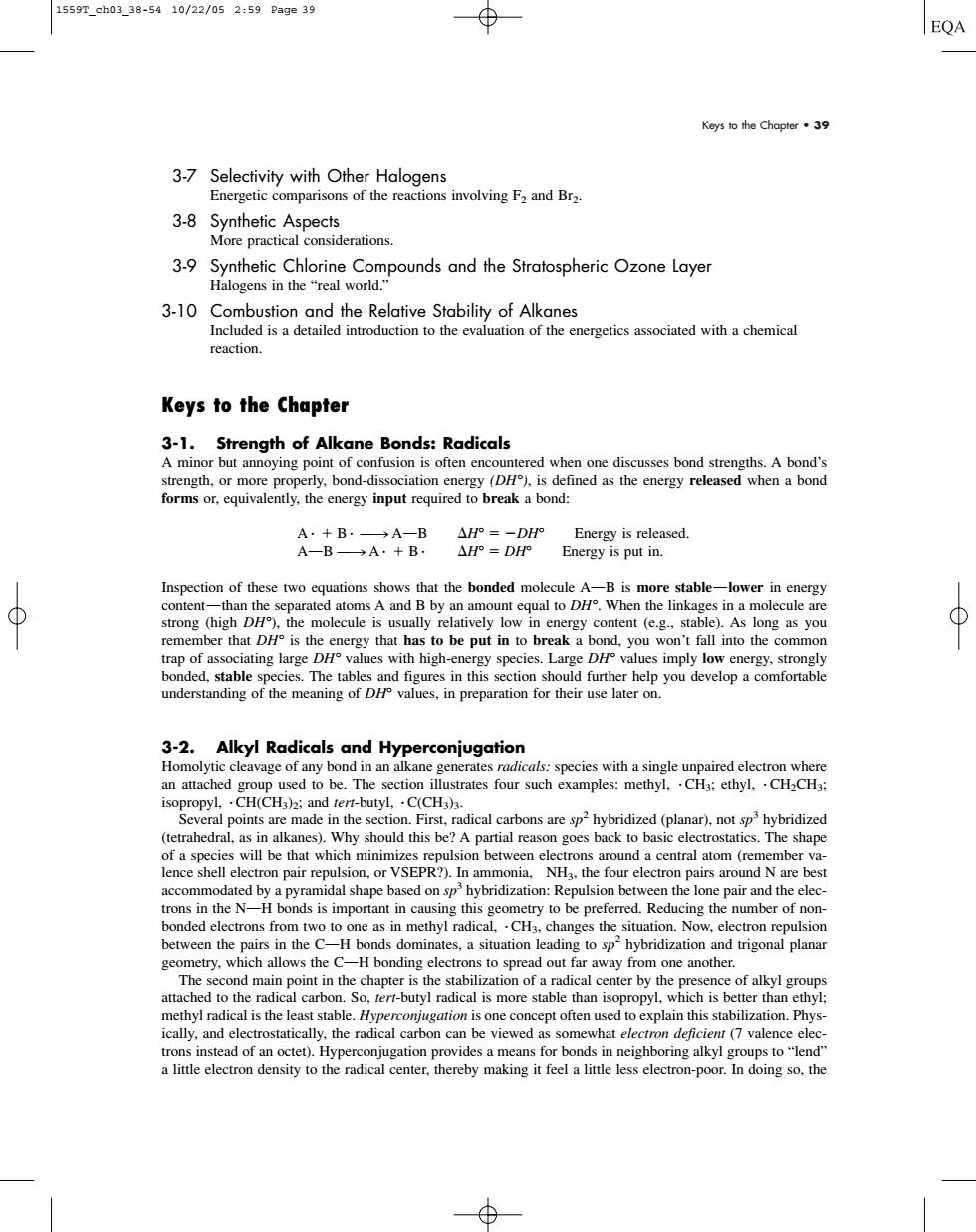正在加载图片...

1559T_ch03_38-5410/22/052:59Pa9e39 EQA Keys to the Chapter·39 3-7 Selectivity with Other Halogens Energetic comparisons of the reactions involving F2 and Br2 3-8 Synthetic Aspects More practical considerations. E AIL e energetics associated with a chemical reaction Keys to the Chapter 3-1.Strength of Alkane Bonds:Radicals A minor but annoying point of confusion is often encountered when one discusses bond strengths.A bond's e energy input require Energy is released. cocction of these to aions ho the honded oe o in nry and B by an an the sneny that has to be put in t ra (g ule ar ting large DH lues with high-en ry species.Large DH ing of theme age of any bond in an alkane generates radicals:species with a single unpaired electron where used to be.The section i strates four such examples:methyl,.CH:ethyl,.CHCH: (tetrahedral,as in alkanes).Why should this be?A partial rease n goes back to basic elec rostatics.The shape or VSEPR?) om (re accommodated by midal shape:Repulsion betwe n the lone pair and the ele trons in the N ds is important in ca etry to be pren ing the number of no between the pairs in theCH bonds dominates.situation leading to shybridization and trigonal planar geometry.which allows the( -H bonding electro ns to spread out far away from one another. methyl radical is the least stable.Hyperconjugation is one concept often used to explain this stabilization.Phy: cally,and ele ly,the radica on can be viewed a (7 valen Keys to the Chapter • 39 33-7 Selectivity with Other Halogens Energetic comparisons of the reactions involving F2 and Br2. 33-8 Synthetic Aspects More practical considerations. 33-9 Synthetic Chlorine Compounds and the Stratospheric Ozone Layer Halogens in the “real world.” 3-10 Combustion and the Relative Stability of Alkanes Included is a detailed introduction to the evaluation of the energetics associated with a chemical reaction. Keys to the Chapter 3-1. Strength of Alkane Bonds: Radicals A minor but annoying point of confusion is often encountered when one discusses bond strengths. A bond’s strength, or more properly, bond-dissociation energy (DH°), is defined as the energy released when a bond forms or, equivalently, the energy input required to break a bond: Aj Bj On AOB H° DH° Energy is released. AOB On Aj Bj H° DH° Energy is put in. Inspection of these two equations shows that the bonded molecule AOB is more stableOlower in energy contentOthan the separated atoms A and B by an amount equal to DH°. When the linkages in a molecule are strong (high DH°), the molecule is usually relatively low in energy content (e.g., stable). As long as you remember that DH° is the energy that has to be put in to break a bond, you won’t fall into the common trap of associating large DH° values with high-energy species. Large DH° values imply low energy, strongly bonded, stable species. The tables and figures in this section should further help you develop a comfortable understanding of the meaning of DH° values, in preparation for their use later on. 3-2. Alkyl Radicals and Hyperconjugation Homolytic cleavage of any bond in an alkane generates radicals: species with a single unpaired electron where an attached group used to be. The section illustrates four such examples: methyl, jCH3; ethyl, jCH2CH3; isopropyl, jCH(CH3)2; and tert-butyl, jC(CH3)3. Several points are made in the section. First, radical carbons are sp2 hybridized (planar), not sp3 hybridized (tetrahedral, as in alkanes). Why should this be? A partial reason goes back to basic electrostatics. The shape of a species will be that which minimizes repulsion between electrons around a central atom (remember valence shell electron pair repulsion, or VSEPR?). In ammonia, NH3, the four electron pairs around N are best accommodated by a pyramidal shape based on sp3 hybridization: Repulsion between the lone pair and the electrons in the NOH bonds is important in causing this geometry to be preferred. Reducing the number of nonbonded electrons from two to one as in methyl radical, jCH3, changes the situation. Now, electron repulsion between the pairs in the COH bonds dominates, a situation leading to sp2 hybridization and trigonal planar geometry, which allows the COH bonding electrons to spread out far away from one another. The second main point in the chapter is the stabilization of a radical center by the presence of alkyl groups attached to the radical carbon. So, tert-butyl radical is more stable than isopropyl, which is better than ethyl; methyl radical is the least stable. Hyperconjugation is one concept often used to explain this stabilization. Physically, and electrostatically, the radical carbon can be viewed as somewhat electron deficient (7 valence electrons instead of an octet). Hyperconjugation provides a means for bonds in neighboring alkyl groups to “lend” a little electron density to the radical center, thereby making it feel a little less electron-poor. In doing so, the 1559T_ch03_38-54 10/22/05 2:59 Page 39����